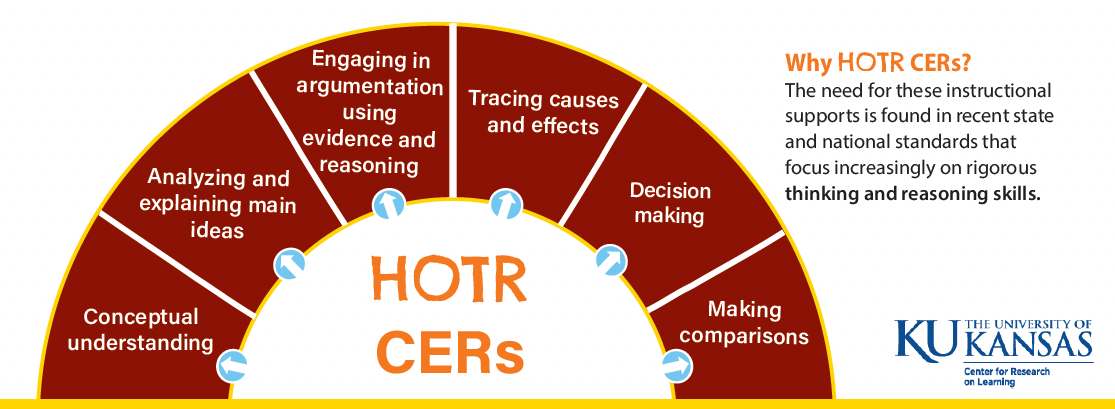Higher Order Thinking and Reasoning Routines (HOTR)
 The HOTR series provides teachers with instructional supports and procedures:
The HOTR series provides teachers with instructional supports and procedures:
- Visual devices or graphic organizers with places to write critical components of the content in the lesson
- Guiding steps on each device that comprise cognitive strategic reasoning supports, each tailored to a specific type of higher order thinking and reasoning
- A common instructional procedure that incorporates explicit instruction, prompts for collaborative development of learning, and components of universal design of learning
HOTR routines help students and teachers compare and contrast information, analyze and evaluate questions to explain main ideas, determine causes and effects of an event, make decisions about different options, and engage in argumentation in both a specific content area (science) and across subjects and curricula.
The Higher Order Thinking and Reasoning (HOTR) Content Enhancement Routines
The Concept Comparison Routine is a teaching procedure that is used to enhance students’ understanding of the similarities and differences between or among two or more concepts by identifying critical characteristics of each, the larger categories to which they belong, and then summarize and extend understanding. This routine addresses higher-order thinking and reasoning from the standards that are cued by terms not only of compare and contrast, but also terms such as discriminate, differentiate, alike and unalike, or similar and dissimilar.
The Question Exploration Routine helps teachers and students explore a critical question, identify necessary vocabulary and background information, break apart that complex question into smaller questions and answer them, arrive at a clear, concise main idea answer, and engage in generalization of the main idea to other issues in the same content area and to issues in the real world. This routine addresses higher-order learning and reasoning from the standards that are cued not only by a critical question, but also terms such as main idea, central theme and core understandings.
The Cause and Effect Routine contains procedural steps that focus on understanding a critical event with its preceding causes and subsequent effects, responding to standards across content areas. Events may be actions, conflicts, new ideas, application of procedures, biological interactions, or literary, social and political happenings, among others. This routine addresses higher-order learning and reasoning from the standards that are cued not only by the term cause and effect, but also terms such as initiate, outcome, result, give rise to, bring about or consequences.
The Decision-Making Routine helps teachers and students identify an issue or problem, options for solving the problem, ways to analyze components of each option, time to consider compromises, and finally, come to a conclusion about recommended responses to the problem or issue. In terms of standards and assessments, questions requiring a decision making may also be phrased with challenges that are cued not only by the term decision making but also terms such as options, alternatives, choices, or judge between.
The Scientific Argumentation Routine is a teaching procedure to help teachers guide students as they acquire the ability to understand and use argumentation in science. Components of argumentation include understanding and evaluation of claims, evidence, reasoning, counterarguments, rebuttals, and explanation of conclusions; this routine was developed specifically for science classes. This routine addresses higher-order learning and reasoning from the standards specifically tailored to science that are cued not only by the term argumentation, but also terms such as considering claims, conclusions, statements of controlled research outcomes or theories, among others.
The Cross-Curricular Argumentation Routine is a teaching procedure that helps teachers guide students as they acquire the ability to understand and use argumentation; it was designed to be used across different content areas. The components of cross-curricular argumentation focus on ways to understand and evaluate claims, evidence, reasoning, counterarguments, rebuttals, and explanation of conclusions with terminology used across many content areas. It is cued by terms in standards in addition to argumentation, such as considering conclusions, statements, assertions, positions, and debate topic that are found across content area standards.
For more information, check out the HOTR Routines Brochure.